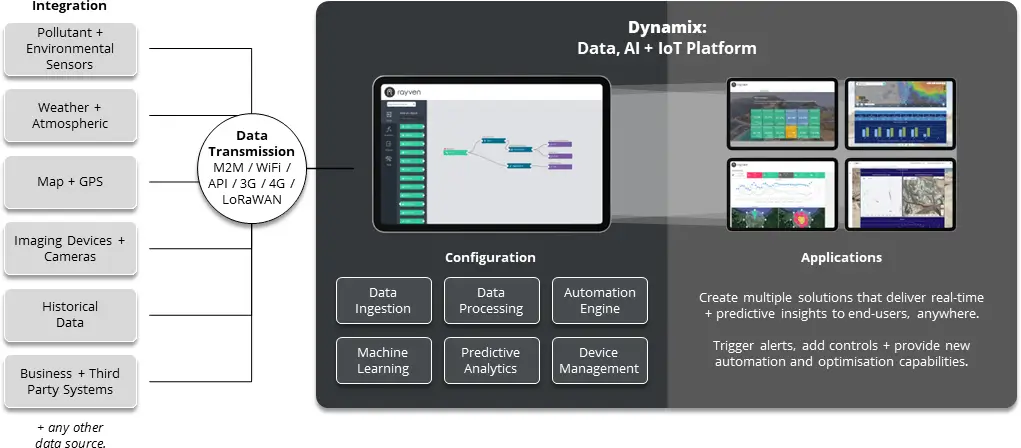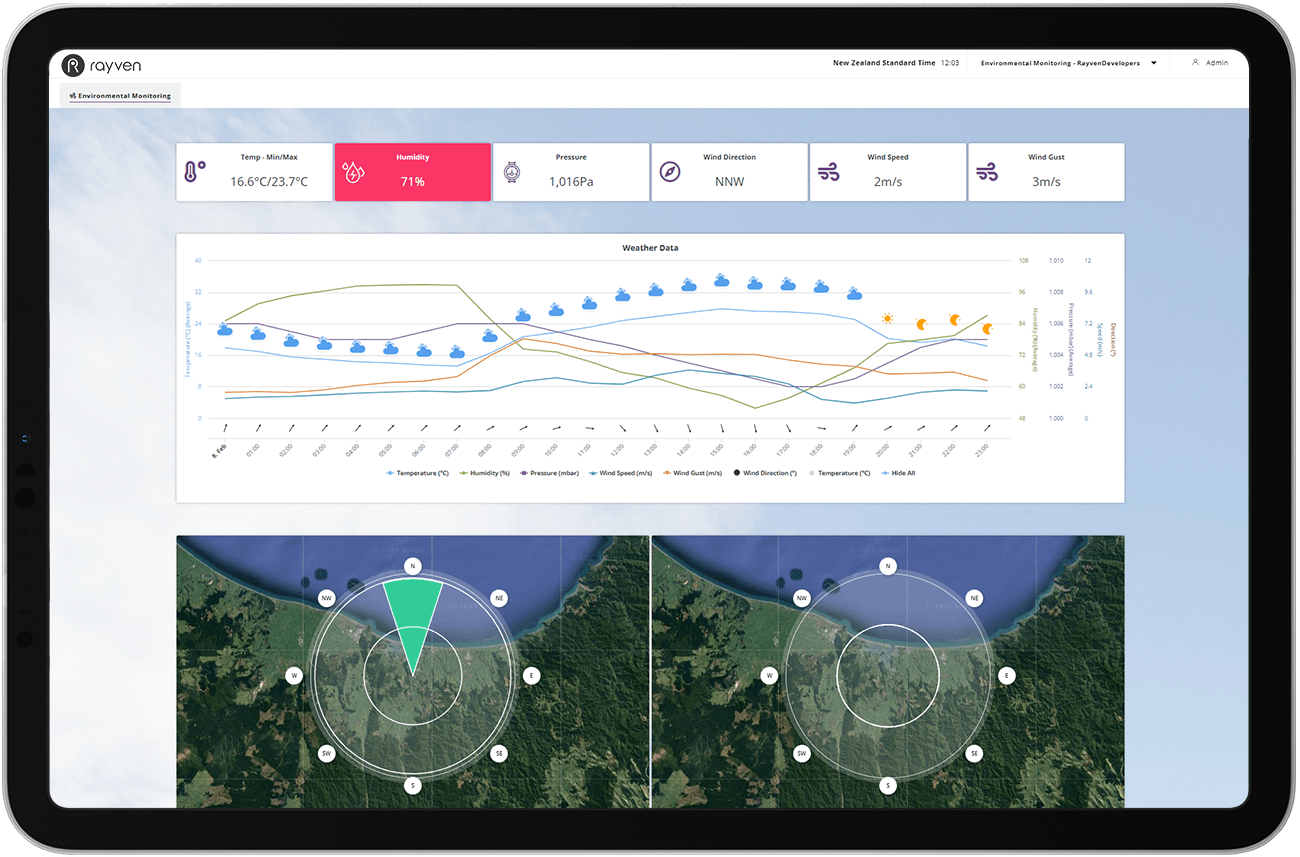Air Quality Monitoring Solutions.
Monitor in real-time, predict levels + mitigate harm, simply.
Rayven is world-leading technology that enables you to easily create + deliver a custom Air Quality Monitoring application, fast and affordably.
Monitor + manage real-time air quality and pollution with a custom, real-time solution.
Conquer the challenge of assessing, monitoring + improving air quality, simply.
Use our Rayven Platform's Air Quality Monitoring solution template as your starting point and integrate infield devices, third-party systems, and assets to deliver real-time and predictive insights on performance and how it can be improved.
Our all-in-one, easy-to-use technology comes complete with universal integration, machine learning, automation, and AI capabilities; enabling you to monitor + maintain a safe, healthy, and compliant environment, simply.
Remote, real-time air quality monitoring.
Deploy sensors and easily integrate them to get accurate, real-time metrics on PMs, gases, metals, GHGs - anything - as well as wind speed, direction + more.
Set thresholds + trigger alerts: make compliance simple.
Set-up thresholds and trigger alerts. Use automation + control to alert people, shutdown machinery, and mitigate problems, fast.
Build interactive dashboards + drill into trends.
Build custom dashboards to explore performance. Interrogate sources, analyse the different factors that contribute to AQI readings; spot trends in Big Data.
Add custom AI + universal automation.
Our solution enables you to utilise inbuilt predictive analytics with your own and third-party data to predict outcomes and take action via custom automations.
Fits all existing
hardware + technologies.
Our air quality monitoring solution will integrate with any machinery, weather system, hardware, sensor, technology, or data repository - guaranteed.
Monitor more: add noise, water, dust - anything.
Incorporate different in-field sensors to develop a complete, real-time view of environmental performance + enhance predictive modelling.
Rayven has free + low-cost options, making it affordable for every business.
How your Air Quality Monitoring solution is put together.
New and existing data, (both real-time and historical), alongside custom logic, thresholds, and predictive analytics is used to create your custom Air Quality Monitoring solution.

Our solution can handle data from anywhere in any format, and at all levels:
Level 1 Data: Manual entry of data via custom forms built within our solutions.
Level 2 Data: Bespoke spreadsheet ingestion via FTP or manual uploads.
Level 3 Data: Integration of real-time data from OT / IT systems and corporate systems.
Level 4 Data: Real-time integration with in-field technologies, asset systems + in-field sensors.
Your Air Quality Monitoring solution will integrate with anything, including:
Air Quality Monitoring solution FAQs.
Question: What is an Air Quality Monitoring solution, and why is it important?
An air quality monitoring solution involves the use of interconnected devices to detect, measure, and transmit data on various aspects of air quality. These devices are often equipped with an array of sensors that can detect pollutants, particulate matter, and other indicators of air quality before then transmitting the data collected to centralised databases, applications, or IoT platforms for analysis. Advanced systems will incorporate machine learning and predictive analytics, delivering real-time insights to users of current and future risks, as well as providing them with advice on how to avoid them.
The importance of monitoring air quality cannot be overstated. Poor air quality can have immediate and long-term health effects, including respiratory and cardiovascular issues, especially in vulnerable populations such as children, the elderly, and those with pre-existing health conditions. Beyond health concerns, polluted air can cause environmental damage.
For businesses, breaches of strict air quality regulations can lead to significant fines and reputational damage, and for those responsible for public health and safety, it enables them to make informed decisions about public health interventions, environmental standards, and policy-making.
Question: What's involved in a Air Quality Monitoring solution?
IoT Monitoring for air quality encompasses a system of interconnected devices, sensors, and software platforms used to monitor, analyse, and manage pollution. Here's how it can work:
- Sensors: Specialised pollutant and environmental sensors can detect specific airborne chemicals and particulates, such as CO, CO2, NO2, SO2, O3, PM2.5, and PM10, as well as capturing ambient conditions like temperature, humidity, and atmospheric pressure, which can influence air quality and sensor calibration. These sensors can be placed strategically in urban, suburban, or even rural areas to create a network that provides comprehensive coverage of a region and/or operational site (such as within mining or large-scale infrastructure projects).
- Data collection + transmission: These sensors collect data continuously or at set intervals. The data is then transmitted wirelessly to a central server or cloud platform. Advanced IoT platforms can handle data from thousands of sensors simultaneously.
- Real-time data analysis: IoT platforms analyse the data to generate insights into the sources and levels of pollutants. Patterns and trends can be identified and delivered to people via data visualisations and dashboards.
- Mapping: Visualisation tools can provide real-time air quality maps as well as predicted movements and future levels. These maps can be updated in real-time, allowing businesses and public administrators to make informed operational decisions.
- Responsive actions + alerts: In advanced setups, the system can be integrated with communication systems and pollution mitigation solutions. For instance, if poor air quality is detected in a specific area, certain operational machinery or activities may be shutdown or further activities prevented.
- Machine Learning + predictive analytics: Use an advanced platform's inbuilt capabilities to analyse multiple data sources, both real-time and historical data, to predict breaches based on conditions. Use it to make better decisions both via human and AI.
- Application: IoT platforms can support worker, regulatory and public-facing apps and dashboards that deliver critical insights in real-time. These enable those responsible for monitoring and reporting on problematic areas to better manage and prevent breaches, as well as supply necessary data to connected parties.
Question: How can real-time air quality monitoring help businesses?
Real-time air quality monitoring at both a micro and macro scale can significantly help businesses and those responsible for managing it:- Compliance with regulations: Many countries and states have strict regulations governing the emission of pollutants from industrial processes. Real-time monitoring ensures businesses stay within permissible limits, avoiding potential legal penalties or shutdowns.
- Operational efficiency: Monitoring can help businesses optimise their processes. For instance, if a particular process is releasing more pollutants than expected, it might indicate inefficiencies or equipment malfunctions that, when addressed, could lead to cost savings.
- Protect employee health: Workers can be exposed to harmful pollutants. Real-time monitoring can trigger alerts when pollutant concentrations exceed safe levels, allowing businesses to take immediate protective measures and ensure a healthy workplace.
- Community relations: Being transparent about air quality can improve relations with the surrounding community. Residents near industrial zones are often concerned about pollution. Sharing real-time air quality data can build trust and show that the company is taking proactive measures.
- Cost savings: By continuously monitoring emissions, businesses can identify and address sources of pollution before they become larger, costlier problems. This can also reduce potential liabilities from regulatory fines or lawsuits.
- Data-driven decisions: The data collected can be used to make informed decisions about equipment upgrades, process changes, or investments in pollution control technologies.
- Emergency response: In case of accidental releases or spills, real-time data can help industries respond more rapidly, minimising harm to the environment and nearby populations.
- Research + Development: Continuous data can guide R&D efforts, helping businesses develop cleaner, more efficient processes, and products.
Question: What are the key features to look for in an Air Quality Monitoring solution?
When purchasing or creating an Air Quality Monitoring solution, it's crucial to look for:
- Real-time data processing: Get immediate analysis and feedback on air quality or AQI readings, providing for instant alerts on threshold breaches.
- Scalability: Ability to handle data from multiple sensors, systems and third-party systems spread across large areas. Expandability to accommodate growth in monitoring infrastructure and different sites - without blowing out costs.
- Data analytics platform: Advanced tools for visualising trends and patterns. Predictive analytics for anticipating potential issues.
- Integration: Compatibility with other IoT systems, legacy business systems, as well as external data sources and SaaS. API support for custom integrations and applications.
- Geo-tagging +mapping: Precise location data and visualisation capabilities using maps for spatial understanding of air quality.
- Secure data transmission: Encryption and secure protocols to protect data integrity. Measures to prevent unauthorised access.
- Alerting +notification system: Customisable thresholds for alerts. Multiple notification channels (email, SMS, app notifications).
- Remote control, configuration + device management: Ability to adjust sensors and other machinery remotely. Over-the-air updates for firmware and software.
- Cloud connectivity + storage: Data stored in a secure cloud environment. Easy access to historical data and trends.
- User-friendly, fully-customisable interfaces: Intuitive dashboards and reporting tools, tailorable for different uses. Mobile access for on-the-go monitoring.
- Regulatory + standard compliance: Adherence to industry standards and regulations related to IoT devices and air quality readings.






















































-1.webp)



